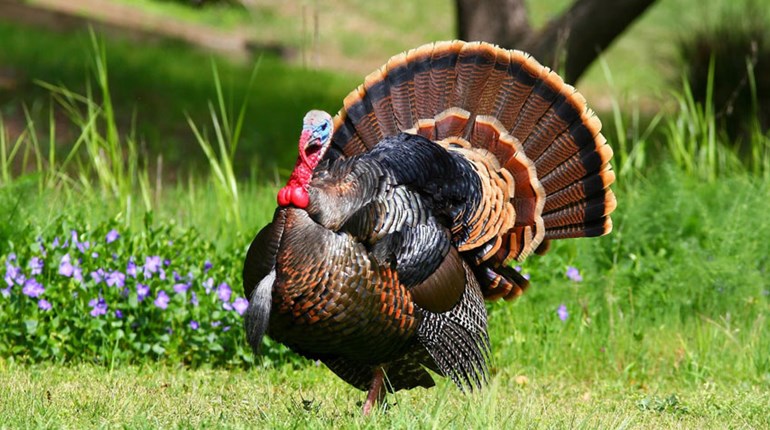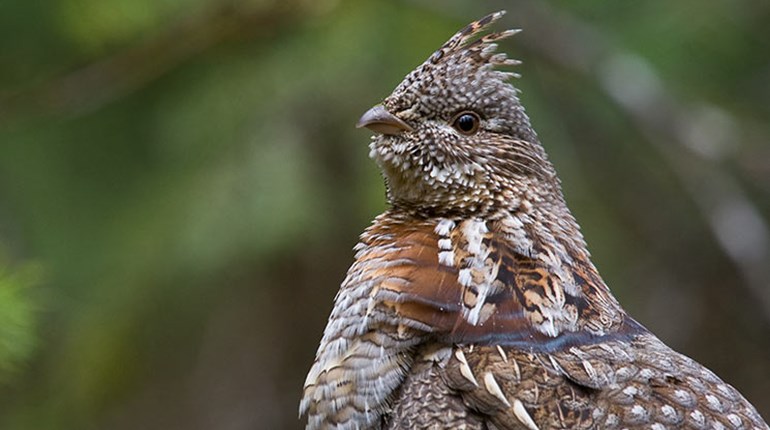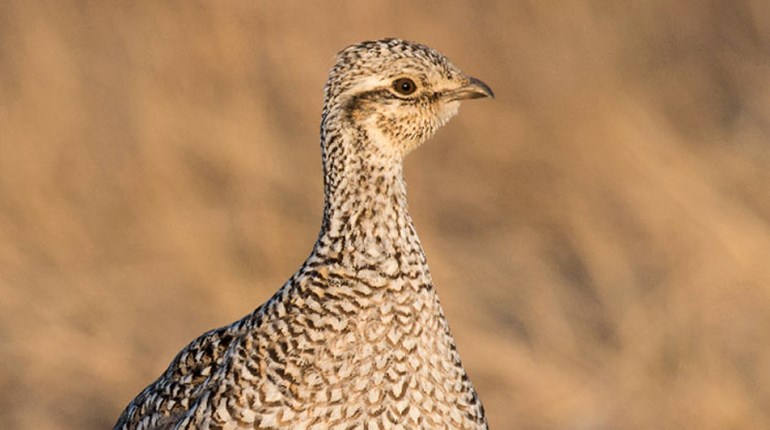
While pheasants seem to hold the interest of most hunters who like shotguns and bird dogs, America has so many other upland bird species to keep you and your dog busy all autumn long. In fact, the chance is strong that one of these species is living somewhere nearby. Study the list, then go out and hunt them. Like all things involving bird dogs and shotguns, there is never a dull moment!
Chukar
This medium-sized gray bird with black-and-white bars along each side of its breast is bigger than a quail and has a distinct orange-colored bill. You'll notice striking black marks on a soft gray background, including a dark line between the white face and the gray neck. Chukar can be fast on their feet and will often dash into brush and cover to hide before flying. These birds are found in Hawaii, plus most Western states from Washington to California, and into Idaho, Wyoming, Nevada, Utah and Colorado. Chukars have also been released on many shooting preserves. In the wild they are found mostly in rocky desert canyons.
bigger than a quail and has a distinct orange-colored bill. You'll notice striking black marks on a soft gray background, including a dark line between the white face and the gray neck. Chukar can be fast on their feet and will often dash into brush and cover to hide before flying. These birds are found in Hawaii, plus most Western states from Washington to California, and into Idaho, Wyoming, Nevada, Utah and Colorado. Chukars have also been released on many shooting preserves. In the wild they are found mostly in rocky desert canyons.
Quail
Affectionately known to Southern hunters as “Mr. Gentleman Bob," the northern bobwhite was once widespread and very common in the Southeast. This small bird can also be found in the Midwest and into Oklahoma and Texas, and as far north as Iowa and Indiana. Habitat improvement projects in places like North Carolina have returned bobwhites to huntable levels in some regions. Often, these small birds are also released on shooting preserves. The white-and-black mask against mostly tan-and-cream feathers makes it a striking bird. Found mostly in brush and around overgrown fields and weedy areas, its distinct call sounds like “bob-white" (hence its name!). Frequently found in large flocks of 10 to 20 birds, the northern bobwhite seems to have nerves of steel. The flock will hold tight until you almost step on one, then erupt into the sky as one.
America has other quail species. The Montezuma quail found in southern Arizona has a  white face and looks like a clown. Both the California and Gambel's quail, found in California, Utah and the Southwest, have a distinct curved black small plume atop the head. These quail are frequently seen walking-or dashing-across open areas such as dry creek beds and canyon floors. The scaled quail, another species, has a white plume on its head, scale-like markings on its side, and is found in west Texas and New Mexico. The mountain quail, gray in color with a long black plume atop its head, is found mostly in the higher Rocky Mountain regions.
white face and looks like a clown. Both the California and Gambel's quail, found in California, Utah and the Southwest, have a distinct curved black small plume atop the head. These quail are frequently seen walking-or dashing-across open areas such as dry creek beds and canyon floors. The scaled quail, another species, has a white plume on its head, scale-like markings on its side, and is found in west Texas and New Mexico. The mountain quail, gray in color with a long black plume atop its head, is found mostly in the higher Rocky Mountain regions.
Gray (or Hungarian) Partridge
These birds, slightly larger than a quail, are commonly referred to as “huns." They are  found in the U.S. Northwest, including Montana and Wyoming, and into the Dakotas and Minnesota. This grey partridge has rust-colored stripes against a dark- to medium-gray lower chest and displays a mostly rust-colored face. Huns are often found in large flocks and are very elusive and wary. They take to wing fast and emit a high pitched “keep, keep" as they wing away and then turn sharply and glide into cover. Many huns are found in flat agricultural ground.
found in the U.S. Northwest, including Montana and Wyoming, and into the Dakotas and Minnesota. This grey partridge has rust-colored stripes against a dark- to medium-gray lower chest and displays a mostly rust-colored face. Huns are often found in large flocks and are very elusive and wary. They take to wing fast and emit a high pitched “keep, keep" as they wing away and then turn sharply and glide into cover. Many huns are found in flat agricultural ground.
Hunting Them:
Most states require the use of a shotgun. Hunters will be well-served with No. 6 for the larger birds, like the grouse, and No. 8 shot on the smaller species like quail. Most states permit hunting with a standard license and a HIP permit. When hunting nearly all upland gamebird species, expect to walk a lot, and to be extra cautious when you pause because this is when most birds become unnerved and take to wing and escape. While hunting, wear leather or good quality gloves to protect your hands from briars or cacti and shooting glasses in clear or yellow to help see the birds.
Hunting dogs such as pointers, labs, Weimaraners, springers and others are frequently used to flush and recover birds.
To learn more about each bird, visit Cornell University's Bird ID website. Here you can hear songs and see the birds in normal habitat.







































